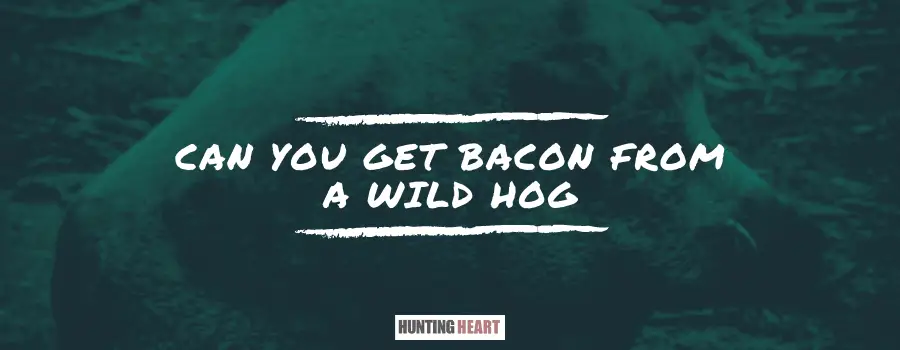As an Amazon Associate I earn from qualifying purchases.
Our Associate portal can be found here
It is no brainer that when you hear of bacon, you think of pork. How about we talk of wild bacon, particularly from feral hogs, but can you get bacon from a wild hog? Yes, you can, and some fantastic bacon for that matter.
Wild hog hunting is one of the most rewarding sports in the fields. In fact, it is even better when one possesses the skinning, gutting, and quartering skill. There are various reasons why people hunt hogs. However, this article concentrates on wild hog meat as a source of human food, specifically bacon.
First, can you tell the difference between wild hogs and pigs? Check out this article!
What Is Wild Hog Meat Called?
If it’s the first time you are coming across an article talking about consuming wild hog meat, then don’t be surprised. Feral hogs are safe for human consumption. Besides, wild hog meat is pork. Having mentioned that it belongs to the pork category, I believe it’s now sinking why wild hog meat makes bacon.
Wild Hog Bacon vs. Pig Bacon
Both are similar except for some slight differences, mainly attributed to the difference in diet. Certainly, wild hog bacon is game meat. When compared to domesticated pig pork, wild hog pork is leaner.
When it comes to color and complexion, wild hog meat is darker than the ordinary pork.
In terms of taste, the wild pork is known for its intensely sweet and nutty flavor resulting from the forage and nuts they ingest.
How to Make Wild Hog Bacon
The secret of making the perfect bacon is using fat hog meat. Generally, bacon comes from the pork belly. Unfortunately, the wild hog’s stomach region is not that thick to make good bacon. However, don’t get discouraged. Since ideally, bacon is meat and fat, all you need is to have is a cut with a 1:1 meat to fat ratio. Therefore, any wild hog meat part that meets the criteria is good for bacon.
Here are the steps to follow when making your wild hog beacon. Be sure to check out the Hog Anatomy for better understanding.
Shape Your Bacon Slab
First, remove all the bones that might be on the cut. In this case, let’s assume you have a 200lb piece from the hindquarter. Place it on your cutting board. With a sharp knife, cut it into two slim halves and its breadth, aiming to have something looking like a bacon slab. Remember, not slices but slabs from which one can cut slices later.
Trim the slabs to have them in even thickness. Although you’re more interested in the slab, also keep the trimmings since they can make bean-like things and other recipes.
Probably you may think the slabs are too big, but no. Why? Because when curing the meat, you will extract a lot of water out, thus the slabs will shrink.
Mix the Cure
Bacon is basically cured pork. Therefore, you have to cure the wild hog fatty meat in various ingredients. Since your slabs are ready, it’s time to mix your cure. Get the below cure ingredients;
- C&H, Cane Sugar, Golden Brown, 2lb Bag
- Morton Salt Kosher Salt, 3 lbs box
- Tone’s Spices Restaurant Black Pepper, 18oz bottle
- Bolner’s Fiesta Curing Salt, 4oz bottle
Don’t worry much about the cure amount to mix, but the more the meat, the more the cure you require. In case you mix too much, you can save what’s left for later use. You only need to put it in freezable containers and later store them in a freezer.
For the meat we have, take 3lb of the Morton Salt and mix with the curing salt – 2 ounces. Curing salt plays an essential role. It prevents harmful bacteria growth and botulism. They both threaten human health.
Add black pepper to your satisfaction, and later add your brown sugar and mix evenly. Use as much or less sugar as you want based on your preferences. However, it is better to note that a lot of sugar makes the bacon stickier when fried.
Prepare the Slabs for Curing
Now you have the slabs and cure ready. Pour the cure on something flat, say baking sheets. Place your slabs on your cure mixture one by one. Press them on the mixture to ensure the entire surfaces are covered with a cure. Flip the slabs on all sides and, where necessary, rub the cure on areas that cannot get enough by pressing.
After, get sealable freezer bags and put your slabs inside. Sealable because the cure extracts water from the meat, which can spill on your fridge, causing a mess. Take caution when inserting the slabs in the freezer bags not to tamper with the cure coatings. Before sealing, ensure you remove all the air inside the bag since oxygen favors bacteria growth.
Cure Your Bacon Slab
After coating and packing your slabs, then put them in a refrigerator to cure. The curing process takes between 3 to 7 days, which depends on the slabs’ thickness.
Place the packed slabs on a refrigerator shelf and, if possible, while on backing sheets or trays that can hold water just in case any of the bags accidentally open. Throughout the curing period, flip the slabs daily to baste them with the extracted brine to ensure thorough curing.
As days go by, the slabs get firmer and denser and also turn red from brown. Squeeze them to tell the firmness. When fully cured, they will be brown.
Wash and Dry the Bacon
Cured slabs are ready bacon. At this point, wash in running water and slice them since they are ready for consumption. However, bacon is savory when smoked. Therefore, if you like them smoked, then smoking is the next thing you should do.
When smoking, wash all the brine off the bacon. When the bacon pieces are fully cured, they are extremely salty, and hence you are to clean them thoroughly. After removing the salt, hang the bacon pieces in a dry and dust-free space for a few days.
Since your wild hog is salty, don’t hang with galvanized or plain wire. In fact, avoid materials that are prone to rust, corrosion, or oxidation.
Drying time varies significantly depending on humidity and temperature levels. The reason you need them entirely dry is so that they can take up smoke. Otherwise, if the wild hog bacon is not dry, it won’t take up any smoke.
Once dry, smoke it nicely for a rich flavor.
Amazon and the Amazon logo are trademarks of Amazon.com, Inc, or its affiliates.

36 years old, been hunting and fishing my entire life – love the outdoors, family, and all kinds of hunting and fishing! I have spent thousands of hours hunting hogs and training hunting dogs, but I’m always learning new stuff and really happy to be sharing them with you! hit me up with an email in the contact form if you have any questions.


